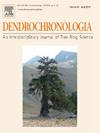美国俄亥俄州东北部白栎树对气候变化的响应:是树龄还是场址年龄?
IF 2.7
3区 农林科学
Q1 FORESTRY
引用次数: 0
摘要
白栎是北美中西部阔叶林的重要物种,在气候变暖和雨水日益增多的地区,白栎在提供生态系统服务方面发挥着重要作用。在过去的一个世纪里,一个树木园里的百年白栎树林,以及俄亥俄州东北部的两个第二生长林(~ 200年)一直对夏季(6 - 7月)降水有积极的反应,而附近的四个老生长林(>;300年)自20世纪70年代中期以来已经失去了对水分的敏感性。这种“干旱减弱的信号”,之前已经报道过,似乎更多的是由于个别地点的土地使用遗留下来的,而不是树木年龄。年轻栎树林及其相对持续的干旱敏感性也与它们最近获得树冠的历史以及与选择性采伐间隔相关的类似响应有关。各站点与夏季(6 ~ 7月)月最高气温呈显著负相关,月最高气温与降水总体呈显著负相关。预计未来中西部地区的变暖将导致春季降水增加,而与北美西风急流向北迁移有关的夏末降水可能减少。预计夏季降水的减少,加上未来几十年夏季最高和最低气温的升高,将增加这些树木的水分胁迫。我们从立地特征和森林年龄方面对这些变化的气候响应的研究有助于未来对树木健康和森林固碳能力的评估,也有助于通过使用一系列树木立地来重建气候,当旧生长地点的敏感性丧失时。本文章由计算机程序翻译,如有差异,请以英文原文为准。
Changing climate response of Northeast Ohio white oaks, USA: Is it tree age or site age?
White oak, a keystone species of the broadleaf forests of the North American Midwest, has a significant role in providing ecosystems services in a region experiencing warming and increasingly pluvial conditions. A one-hundred-year-old white oak stand in an arboretum, along with two second growth (∼200-year-old) stands from Northeast Ohio have consistently responded positively to summer (June-July) precipitation over the past century, whereas four nearby old growth sites (>300 years old) have lost their moisture sensitivity since about the mid 1970s. This “fading drought signal,” which has been previously reported, appears to be more a result of the legacy of land use at the individual sites rather than tree age. The younger oak stands and their relative sustained drought sensitivity is also related to their history of recently attaining the canopy and similar responses associated with intervals of selective logging. All sites are strongly, negatively correlated with summer (June-July) maximum monthly temperatures and in general the maximum temperatures are negatively correlated with precipitation in those months. Future warming in the Midwest is projected to see increases in spring precipitation and likely decreases in late summer precipitation linked to a northward migration of the North American Westerly Jet. This projected decrease in summer precipitation coupled with an increase in maximum and minimum summer temperatures in the coming decades would increase the moisture stress on these trees. Our examination of these varying climate responses with respect to site characteristics and forest age can help future assessments of tree health and the forest’s ability to sequester carbon, as well as facilitate efforts to reconstruct climate by using a range of tree sites for intervals when sensitivity in old growth sites is lost.
求助全文
通过发布文献求助,成功后即可免费获取论文全文。
去求助
来源期刊

Dendrochronologia
FORESTRY-GEOGRAPHY, PHYSICAL
CiteScore
5.50
自引率
13.30%
发文量
82
审稿时长
22.8 weeks
期刊介绍:
Dendrochronologia is a peer-reviewed international scholarly journal that presents high-quality research related to growth rings of woody plants, i.e., trees and shrubs, and the application of tree-ring studies.
The areas covered by the journal include, but are not limited to:
Archaeology
Botany
Climatology
Ecology
Forestry
Geology
Hydrology
Original research articles, reviews, communications, technical notes and personal notes are considered for publication.
 求助内容:
求助内容: 应助结果提醒方式:
应助结果提醒方式:


